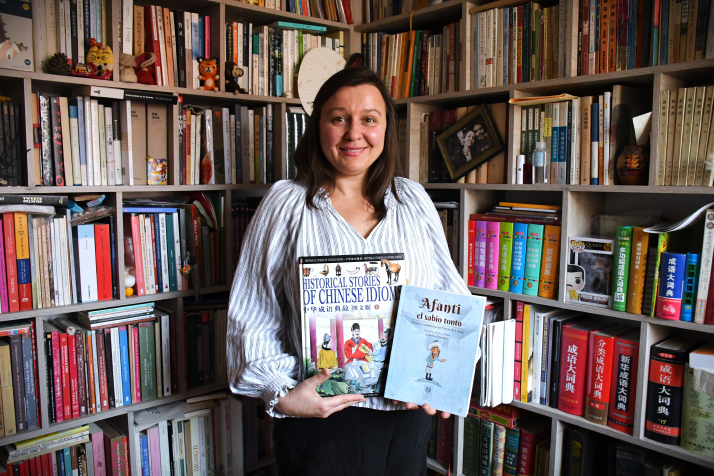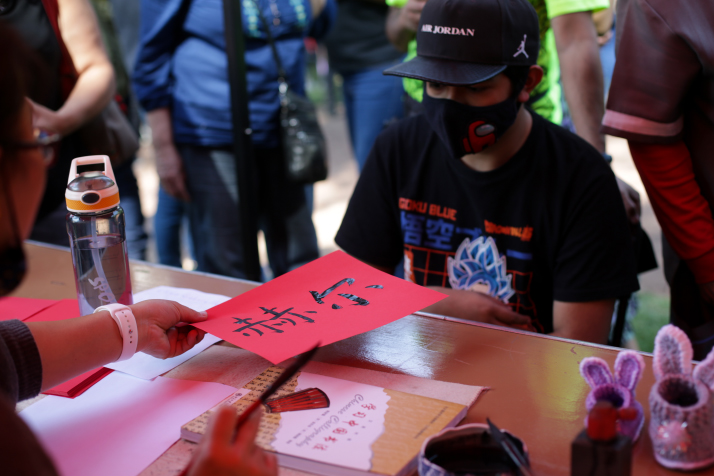| Lifestyle |
| A cultural catalyst | |
|
|
 Radina Dimitrova poses for a picture standing in the small "Chinese corner" of her home in Mexico City, capital of Mexico (JUAN CARLOS AGUILAR)
At the National School of Languages, Linguistics and Translation (ENALLT) at the National Autonomous University of Mexico in the country's capital of Mexico City, Sinologist Radina Dimitrova is recognized by both students and colleagues for her dynamic approach as a teacher of Chinese-Spanish translation. She is known for her ability to juggle multiple projects; often, she is already immersed in two new projects while still completing another. Even during the challenges posed by the COVID-19 pandemic, Dimitrova collaborated with her students to conduct online translation projects. Dimitrova, of Bulgarian origin, shared with China Hoy, a Spanish-language monthly published by China International Communications Group Center for the Americas, that the 15 years she has lived in Mexico "have been the best thing that's ever happened to me." It was there where, for the first time, she was able to unleash her two greatest passions in life: the Chinese and Spanish languages. "China ruled my life for a decade, between the ages of 20 and 30, and now I am putting all my knowledge at the service of Mexicans," Dimitrova said. "Mexico does not teach Sinology or higher studies of, for example, classical Chinese, so I can approach these aspects and develop them with total freedom," she explained. Pitches and proverbs In early March, Dimitrova was particularly happy as one of her numerous projects had come to fruition: the digital platform called Chinese Tales: Chinese Proverbs and Their Stories. The portal, hosted on the ENALLT website, was established with the dual purpose of providing academic assistance to students studying Chinese while also captivating a wider audience interested in exploring these timeless tales, regardless of language-learning intentions. Leading the initiative alongside Ioana Cornea, a notable figure within Mexico's academic community who is known for her expertise in the field of languages and translation, Dimitrova enlisted students to contribute their translation and design skills to the project. Chinese Tales serves as a valuable resource for students of the Chinese language to delve into expressions rich in cultural significance that can be challenging to comprehend and translate. "For a long time, I had wanted to do something with classical Chinese proverbs (chengyu in Chinese), which are very brief (mostly four characters) and very old (even dating back 2,500 years) phrases that come from books on philosophy and literature. They are small capsules of condensed wisdom that refer to stories starring great philosophers, famous rulers, ministers or, as is often the case with fables, animals," she continued. Dimitrova gave the example of a proverb that depicts a fight between a heron and a clam, with a fisherman ultimately benefiting by capturing both. She likened this moral lesson to the myths of Aesop, a legendary figure from ancient Greece renowned for his fables, and Jean de La Fontaine, a French poet and fabulist who lived in the 17th century, where the theme of a third party benefiting from the conflict between two others prevails. This type of universal moral underscores the value of cooperation and mutual benefit. She emphasized the meticulous attention they paid to the quality of their bibliographic sources to ensure that they were working with original, unaltered proverbs. Dimitrova highlighted their focus on the cultural aspect and the authenticity of sources to preserve the integrity of the original quotes. Once they'd selected the proverbs they were going to work with, they decided to present them as follows: first the original in Chinese characters, then its literal translation into Spanish and then its explanation, both in Chinese and Spanish.  A Mexican participant at a Chinese calligraphy workshop during an event themed on Chinese culture in Mexico City, capital of Mexico,on January 21, 2023 (XINHUA)
Word of mouth Dimitrova underlined the importance of orality in Chinese literary culture, highlighting how it had enabled the remarkably accurate transmission of ancient proverbs to the present day. She said this oral tradition, back in the day, had fostered a connection between the general public and ancient storytellers and poets, generating an interactive and communal method of sharing knowledge. This contributed to the democratization of culture in China, shifting it from an exclusive domain to a more inclusive and accessible sphere. For more than three millennia, Chinese literary culture was predominantly reserved for the upper echelons of society. However, gradually, through the oral dissemination of literature, it evolved into a popular culture accessible to a wider audience. Additionally, texts began to be crafted in a style closely mirroring everyday spoken language, enhancing their accessibility and appeal to the common public. The Mexico-based Bulgarian recounted a story about an ancient Chinese poet who had a unique approach to sharing his work. He would recite his poems to elderly women he met along the road to ensure they understood his words. Following each recitation, he would ask, "Did you understand it?" If any confusion arose, he would refine the verse to improve clarity. This anecdote highlights the poet's awareness of the power of spoken language as a key medium through which the general public could grasp and appreciate his poetic creations. Wholly immersed But how did a Bulgarian woman become somewhat of a cultural ambassador of China in Mexico? Learning languages has always come naturally to Dimitrova. By the early 1990s, at the age of 13, she was already fluent in three—Bulgarian, Russian and English—and decided to embark on learning Spanish. For five years, this was her No.1 passion, to the point that her initial career aspiration was to become a translator of Latin American literature. She immersed herself in the works of Argentine authors such as Julio Cortázar and Jorge Luis Borges, and the works of Spanish writer Federico García Lorca with fervor. She dedicated herself so intensely to her translation projects that she once collapsed from sheer exhaustion. Then along came Chinese, a language she studied with the same dedication. "China ruled my life for a decade," she reiterated. After obtaining a bachelor's in Sinology from the University of Sofia in Bulgaria, she went on to pursue a master's degree in ancient Chinese literature in the Chinese city of Wuhan, Hubei Province. While living in China, she encountered a Mexican colleague who told her, "You should go do your Ph.D. in Mexico." He told her about the academic possibilities she would find in this country. She didn't hesitate and traveled to Mexico. "I can't cover everything, but I'm a good guide. I encourage my students to bring contemporary Chinese culture to the Mexican market, whether it be graphic novels or anything else. Whatever you know, the most important thing is to take it to the public. I am someone who works at the service of the people, bringing them knowledge, information, and projects," Dimitrova said. She is, indeed, a dynamic woman. Copyedited by Elsbeth van Paridon Comments to yanwei@cicgamericas.com |
|
||||||||||||||||||||||||||||
|
